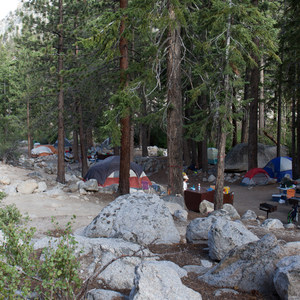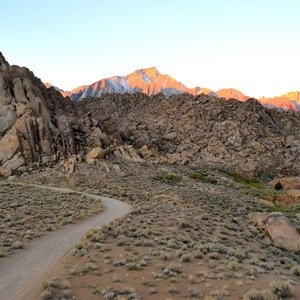This epic trail climbs all the way from the Owens River Valley to Shepherd Pass, for a net elevation gain of nearly 6,000 feet in about 11 miles. As if that wasn't burly enough, the trail actually loses more than 700 feet about one-thrid of the way through, making the total elevation gain and overall steepness much more dramatic. It's a worthy backpacking trip (or one epic day hike) for it's own sake, but many people hike it for the purpose of climbing Mount Tyndall or Mount Williamson, making Shepherd Pass Trail one of the toughest 14er approaches in the Sierra Nevada.
The distance and elevation are significant, but it's a well-built trail with good campsites and water availability, so it's quite doable for those who can pace themselves. Anvil Camp, at about mile 8 and 10,300 feet elevation, makes a good first night's camp if you want to break it up. It's located at a stream and among the trees.
The most scenic camp is of course at Shepherd Pass itself, with coveted tent spots at a small lake with alpine views. The location at over 12,000 feet makes it quite cold and exposed, however. Some parties choose to leave camp at Anvil and day hike to the pass instead.
This hike is easiest in mid July through August, when temperatures are most comfortable and conditions are relatively dry. Earlier than that, you're likely to encounter lingering snow and swift creek crossings. Even into August, a snowfield gaurds the final section of trail to reach the pass. On a warm summer day it should be soft enough to cross without difficulty, but traction devices and an axe can be useful.
From Shepherd Pass, there's a world of further objectives you may choose to tackle. Cheif among them is 14,375-foot Mount Williamson, but it's a full-on scramble suited for experienced peakbaggers. The more accessible 14er is Mount Tyndall, which is clearly visible from the pass and has relatively straightforward routes to its summit, like the North Rib. Besides the two 14ers, several other prominent summits are within reach of the pass, including Mount Keith and Junction Peak. There's also the John Muir Trail, just a few miles west by trail, so the hike to Shepherd Pass can be the start of a much longer backpacking trip in the High Sierra.
Note that any overnight trip in this part of Inyo National Forest requires a wilderness permit, which can be reserved in advance. Once at the pass, the trail enters Sequoia National Park, which does not require a separate permit but has its own set of regulations to follow. Be sure to read up on these when you secure the permit.











Comments
Sign In and share them.